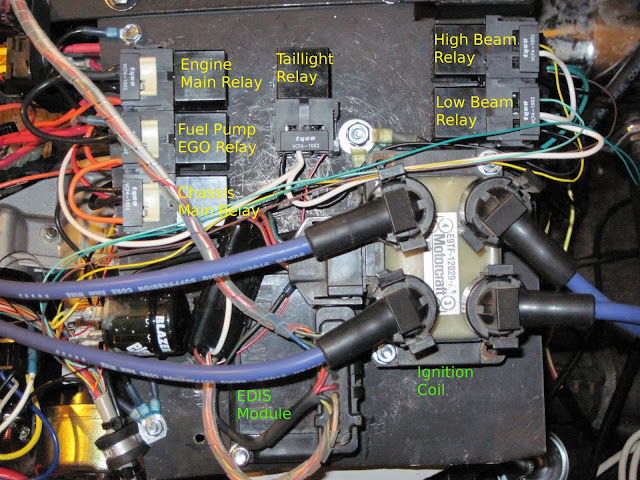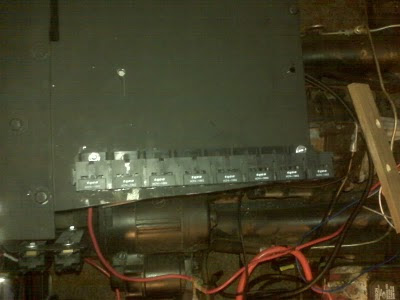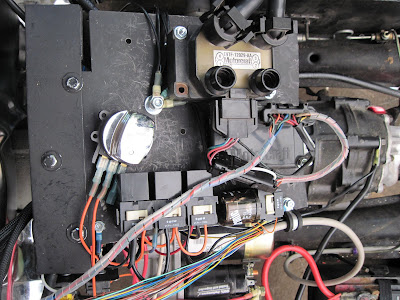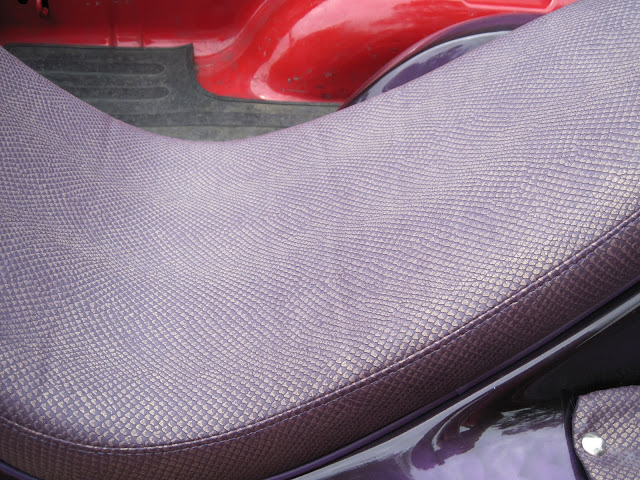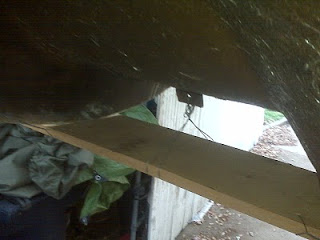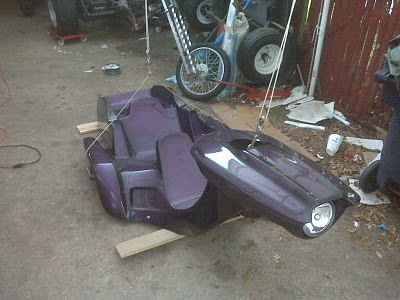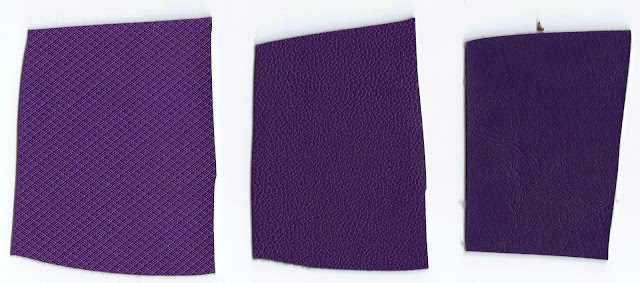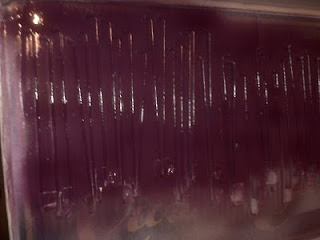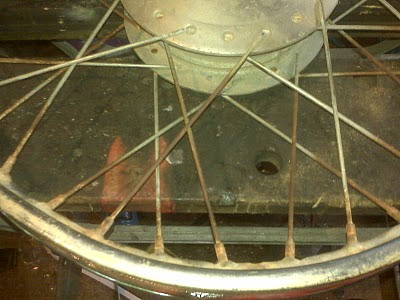The trike was a hit at the event. Sadly, I could not take it anywhere due to the shifter issue. I had to fight for any gear I could find and leave it there as long it would stay. The site had what could best be described as decent dirt roads and most any significant bump would make it jump out of gear, a clear symptom of the problem.
After we got home last night, I sat down and looked at Jamar shifters. I think I can adapt one to my situation if replacing the stock shift rod hanger doesn't work well enough. I think it likely will.
The ones on the trike (it has two to support the length of the initial shaft) were cut in the ring. I think someone chose to do that rather than go to the rather frustrating trouble to properly replace the shaft bushings. To do it correctly, the shaft needs to be pulled out, new bushings installed and the shaft put back in. Because of the welds on the u-joints on this shaft, they don't fit though the installed bushings. With the ring on the hanger split, you can bend the ring open enough to slide the bushings into place. Trouble is, the ring is weakened when bent and more bending makes it worse. It gets so weak that normal shifter motion can push the ring open. Eventually, it will break.
I have a new shift rod hanger. It should be easy enough to pull the shaft out, cut off the old hanger and weld on the new one. I may need to dress the u-joint welds a bit to reinstall the shaft, but next time it will be much easier.
After that, I hope to have it roadworthy enough to do some tuning on the engine. With what little riding I was able to do, I think it goes lean at higher throttle openings, which only makes sense. I couldn't experiment there in the driveway :)
Blog Archive
-
▼
2010
(41)
-
▼
May
(15)
- Shifter Trauma
- It's not intolerable...
- Almost made it
- Closer... closer....
- Body Wiring
- My Feet Are Tired!
- Lights at the End of the Tunnel
- Lots of Wiring
- Upholstery Done!
- Chassis work begins
- Upholstery Finally Underway
- Getting Ready for Upholstery
- Going in to turn four
- Wheel work continues
- Front wheel
-
▼
May
(15)
Monday, May 31, 2010
Saturday, May 29, 2010
It's not intolerable...
There will be a much more detailed breakdown of all the good and bad, but here's a quick assessment from my short test ride.
The engine did pretty well, better than I expected, really. It was drivable. It felt like a standard 1600 with a 009 distributor, a little balky off idle, but it pulled pretty good. At least in the gears I was able to use.
Earlier today, I discovered a problem with the shifter and sure enough, I had to deal with it. In my ride, the only sequential gears I got was 3rd and 4th, and I was going much too slow for 4th. I never actually engaged 2nd or reverse, but I ground them down a bit.
The clutch and brake both take more effort than I'm used to, but I don't suppose that's actually a problem.
The worst thing is that the bars are VERY close. Turning to either extreme caused them to meet me in the ribs.
On the other hand, it seems to fit Gabby pretty well.... :)
The engine did pretty well, better than I expected, really. It was drivable. It felt like a standard 1600 with a 009 distributor, a little balky off idle, but it pulled pretty good. At least in the gears I was able to use.
Earlier today, I discovered a problem with the shifter and sure enough, I had to deal with it. In my ride, the only sequential gears I got was 3rd and 4th, and I was going much too slow for 4th. I never actually engaged 2nd or reverse, but I ground them down a bit.
The clutch and brake both take more effort than I'm used to, but I don't suppose that's actually a problem.
The worst thing is that the bars are VERY close. Turning to either extreme caused them to meet me in the ribs.
On the other hand, it seems to fit Gabby pretty well.... :)
Almost made it
I tried very very hard, but I just didn't make it before midnight.
It is only about 12:30, though!
I'm about to take a late night test ride... I'm sure my neighbors will appreciate it....
It is only about 12:30, though!
I'm about to take a late night test ride... I'm sure my neighbors will appreciate it....
Friday, May 28, 2010
Closer... closer....
I finished the body wiring, complete with split sheathing...
 Headlight and turn signal connectors
Headlight and turn signal connectors
Keyswitch connectors
The need to vigorously clean the fiberglass in order for tie downs to stick is apparent. I suspect they still may come loose, at which time I will epoxy on some kind of cleat.
Under seat span
Termination point. Connectors are hanging below
Also evident is my desire to wrap the wiring in *something*. There split sheath, two colors of spiral wrap and one braided sleeve in the this picture.
Tail / Stop / Turn wiring
The two tail light units were slight different, one being quite old, supplied with the trike when I bought it. The older one had a screw in it for ground; the newer one was missing the push on terminal for the turn lamp. I used short jumper wires with connectors to work around both issues.
The taillights need a gasket to properly fit and seal, but they meet the 10 foot rule quite well...
I got about 2 more inches of altitude, and thus fuel pump clearance, for the fuel tank. I started the engine several times, and almost immediately, it was running extra lean andshopwing low fuel pressure. I presumed the filter was probably clogged. Since the tank should have been exceptionally clean after applying the POR15 liner, I wondered if the liner had dissolved due to the alcohol content of our modern gasolines. I fumbled around until I found a light source to inspect the inside of the tank. I discovered that I was suffering not from liner dissolution or clogged filter, but rather a dearth of fuel. Some of those tests must have burned VERY rich.
Besides the other fuel tank bracket, you can see where I elected to put the obnoxiously loud airhorn. It was nearly $50, but wow can it be heard.
I installed a couple of Mr Gasket sparkplug wire loom. Because it's chrome, it doesn't show up very well in this photo, but it looks really nice in person.
Relocated fuel filter; it was too close to the axle and the line was too close to the moving clutch parts. I also rerouted the power lead to the fuel pump.
The raised fuel tank comes pretty close to the shock tower, but at least that's the stationary end!
That's all I have pictures for. I also connected the IDM pin of the EDIS module to the tach input on the speedo. I had to adjust the count for 0.5 rotations per signal, but it reads RPM now! I also set a 4000 RPM shift point. At the appointed RPM, the tach bargraph will flash.
I'm almost positive I did more than this, but I think I am too sleepy to remember them just now....
Keyswitch connectors
The need to vigorously clean the fiberglass in order for tie downs to stick is apparent. I suspect they still may come loose, at which time I will epoxy on some kind of cleat.
Under seat span
Termination point. Connectors are hanging below
Also evident is my desire to wrap the wiring in *something*. There split sheath, two colors of spiral wrap and one braided sleeve in the this picture.
Tail / Stop / Turn wiring
The two tail light units were slight different, one being quite old, supplied with the trike when I bought it. The older one had a screw in it for ground; the newer one was missing the push on terminal for the turn lamp. I used short jumper wires with connectors to work around both issues.
The taillights need a gasket to properly fit and seal, but they meet the 10 foot rule quite well...
I got about 2 more inches of altitude, and thus fuel pump clearance, for the fuel tank. I started the engine several times, and almost immediately, it was running extra lean andshopwing low fuel pressure. I presumed the filter was probably clogged. Since the tank should have been exceptionally clean after applying the POR15 liner, I wondered if the liner had dissolved due to the alcohol content of our modern gasolines. I fumbled around until I found a light source to inspect the inside of the tank. I discovered that I was suffering not from liner dissolution or clogged filter, but rather a dearth of fuel. Some of those tests must have burned VERY rich.
Besides the other fuel tank bracket, you can see where I elected to put the obnoxiously loud airhorn. It was nearly $50, but wow can it be heard.
I installed a couple of Mr Gasket sparkplug wire loom. Because it's chrome, it doesn't show up very well in this photo, but it looks really nice in person.
Relocated fuel filter; it was too close to the axle and the line was too close to the moving clutch parts. I also rerouted the power lead to the fuel pump.
The raised fuel tank comes pretty close to the shock tower, but at least that's the stationary end!
That's all I have pictures for. I also connected the IDM pin of the EDIS module to the tach input on the speedo. I had to adjust the count for 0.5 rotations per signal, but it reads RPM now! I also set a 4000 RPM shift point. At the appointed RPM, the tach bargraph will flash.
I'm almost positive I did more than this, but I think I am too sleepy to remember them just now....
Thursday, May 27, 2010
Body Wiring
I had several delays and thus started a little late, but I managed to get a bit done.




What's left on the body is to mount and connect the tail lights and secure the wiring to the body. I see JB Weld in my near future.
I have a plan that might work to mount the turn signals on the body, but I'm pretty sure they will go on the front end. I think they will look better there.
 Along with few 'little' things like relocating the fuel filter (the filter is too near axle and the fuel line too near clutch lever), mounting my obnoxiously loud horn and installing the bumper (besides the protection it provides and the trailer hitch, the license plate mounts on the bumper), the major things keeping it off the road will be building the throttle cable and the front wheel/tire.
Along with few 'little' things like relocating the fuel filter (the filter is too near axle and the fuel line too near clutch lever), mounting my obnoxiously loud horn and installing the bumper (besides the protection it provides and the trailer hitch, the license plate mounts on the bumper), the major things keeping it off the road will be building the throttle cable and the front wheel/tire.
I say wheel/tire because if I don't get the new(ish) wheel relaced in time for the weekend, I need to at least change the tire on the old wheel.
The throttle cable shouldn't be difficult, but it cannot be skipped!
The only purchase I think I will need to make is grips and a second mirror mount.
Of course, once it's actually on the road, I still need to tune the EFI system. I think I can have it running reasonably for the weekend, though probably not optimally.
Hey, if I don't get stranded in the median on I-20, I'll be well beyond pleased.




What's left on the body is to mount and connect the tail lights and secure the wiring to the body. I see JB Weld in my near future.
I have a plan that might work to mount the turn signals on the body, but I'm pretty sure they will go on the front end. I think they will look better there.
 Along with few 'little' things like relocating the fuel filter (the filter is too near axle and the fuel line too near clutch lever), mounting my obnoxiously loud horn and installing the bumper (besides the protection it provides and the trailer hitch, the license plate mounts on the bumper), the major things keeping it off the road will be building the throttle cable and the front wheel/tire.
Along with few 'little' things like relocating the fuel filter (the filter is too near axle and the fuel line too near clutch lever), mounting my obnoxiously loud horn and installing the bumper (besides the protection it provides and the trailer hitch, the license plate mounts on the bumper), the major things keeping it off the road will be building the throttle cable and the front wheel/tire.I say wheel/tire because if I don't get the new(ish) wheel relaced in time for the weekend, I need to at least change the tire on the old wheel.
The throttle cable shouldn't be difficult, but it cannot be skipped!
The only purchase I think I will need to make is grips and a second mirror mount.
Of course, once it's actually on the road, I still need to tune the EFI system. I think I can have it running reasonably for the weekend, though probably not optimally.
Hey, if I don't get stranded in the median on I-20, I'll be well beyond pleased.
Wednesday, May 26, 2010
My Feet Are Tired!
After setting out some grass in the front yard and doing so overdue pool maintenance, I got to wiring. By midnight, I had reached a hard stopping point, though slightly short of my goal. I had wanted to have *all* chassis wiring done, but I am short a horn, need to do some ECU programming before I hook up the N light and I need something to make the alternator light work right.
A Volkwagen alternator needs a filament bulb to make the built in voltage regulator work right, so you can't just put an LED on it. I have a generic indicator light that I have been using. It's pretty common to put an LED indicator in parallel and put the LED on the dash. However, the voltage that lights the light is low enough that it wont light the LED on my speedometer. I will need to investigate, but in the mean time, I will put in a temporary switched 12V lead to my generic indicator because it won't charge without the bulb in place.
I replaced the "standard" electronic flash that I had with a flasher made for LEDs. Where the other flasher needs a load of about 1A to flash correctly, this one is rated for 20mA to 25A. It works perfectly with the relays. In this setup, the relays and the LED turn indicators on the speedo are the only load on the flasher. It drives a relay and the lights are driven from the relay.
Since I am out of Tyco sockets for the Bosch relays (who'd have thought eight wouldn't be enough?!) I used a relay with a mounting tab and a regular pigtail socket for the horn circuit. Since the pigtail sockets also have a facility for connecting them together, I put the flasher in an adjacent connector and ziptied the flasher to the relay, which is mounted to the plate with the other relays. It looks better than it sounds. All I need now is a horn, hopefully a loud one.
I put wire and connectors on for the body wiring, headlights, taillights, brake lights and turn signals, along with a spare wire that I envision as being for some kind of accessory lighting. I also connectorized the keyswitch, which will also be on the body soon.
I spent a significant amount of time cleaning up the wire routing and putting in zip ties and spiral cable wrap. Some of the wiring cleanup involved making an extension cable or two so that certain wires weren't stretched like guitar strings.
All in all, I have very little chassis wiring left before it's inspection ready. The alternator and N indicators are really optional, as is the tachomter (need some diodes to wire than in) and the speedometer sensor (front wheel; electrically very simple, but I'd like to hide the wiring to it as well as I can; it will be running down the chrome springer front end.
Tomorrow, a couple of mechanical issues and body wiring... Hopefully I won't have to stand and stoop the whole time!
A Volkwagen alternator needs a filament bulb to make the built in voltage regulator work right, so you can't just put an LED on it. I have a generic indicator light that I have been using. It's pretty common to put an LED indicator in parallel and put the LED on the dash. However, the voltage that lights the light is low enough that it wont light the LED on my speedometer. I will need to investigate, but in the mean time, I will put in a temporary switched 12V lead to my generic indicator because it won't charge without the bulb in place.
I replaced the "standard" electronic flash that I had with a flasher made for LEDs. Where the other flasher needs a load of about 1A to flash correctly, this one is rated for 20mA to 25A. It works perfectly with the relays. In this setup, the relays and the LED turn indicators on the speedo are the only load on the flasher. It drives a relay and the lights are driven from the relay.
Since I am out of Tyco sockets for the Bosch relays (who'd have thought eight wouldn't be enough?!) I used a relay with a mounting tab and a regular pigtail socket for the horn circuit. Since the pigtail sockets also have a facility for connecting them together, I put the flasher in an adjacent connector and ziptied the flasher to the relay, which is mounted to the plate with the other relays. It looks better than it sounds. All I need now is a horn, hopefully a loud one.
I put wire and connectors on for the body wiring, headlights, taillights, brake lights and turn signals, along with a spare wire that I envision as being for some kind of accessory lighting. I also connectorized the keyswitch, which will also be on the body soon.
I spent a significant amount of time cleaning up the wire routing and putting in zip ties and spiral cable wrap. Some of the wiring cleanup involved making an extension cable or two so that certain wires weren't stretched like guitar strings.
All in all, I have very little chassis wiring left before it's inspection ready. The alternator and N indicators are really optional, as is the tachomter (need some diodes to wire than in) and the speedometer sensor (front wheel; electrically very simple, but I'd like to hide the wiring to it as well as I can; it will be running down the chrome springer front end.
Tomorrow, a couple of mechanical issues and body wiring... Hopefully I won't have to stand and stoop the whole time!
Tuesday, May 25, 2010
Lights at the End of the Tunnel
I see them.
Tonight was mostly wiring relays, but that sounds deceptively quick and easy. I connected coil and power to 5 relays that control the headlight, taillights, and turn signals.
All these wires will be dressed up when I'm completely done!
I also wired the starter relay. It is zip-tied to the starter itself to save me room for another relay socket.
What's left to wire on the chassis:
front turn signals
speedometer sensor
connector or two to connect the relay outputs to the wiring for the body
brake light switch
horn relay and horn
a connector the license plate/trailer plug on the bumper
optional back up lights
I will then need to install the tail lights on the body and wire them and the headlight to a connector or two to mate the connectors on the chassis.
The hardest mechanical work left is to remove the fender brackets, though I will be putting the fenders on at a later date. Removing the brackets may involve removing the wheels. I also need to add spacers to lift the body so that it clears stuff it didn't used to clear, like the engine and the springs on the front end. That will mostly involve stacking washers or cutting wood blocks or something for four spots, but I will need to weld an extension on the frame tab under the seat.
That should have everything to the point where it can be inspected and become street legal for the first time since it was wrecked sometime in the '80's!
I need a proper permanent footrest, though that will doubtlessly need to wait until after the weekend.
Tonight was mostly wiring relays, but that sounds deceptively quick and easy. I connected coil and power to 5 relays that control the headlight, taillights, and turn signals.
All these wires will be dressed up when I'm completely done!
I also wired the starter relay. It is zip-tied to the starter itself to save me room for another relay socket.
What's left to wire on the chassis:
front turn signals
speedometer sensor
connector or two to connect the relay outputs to the wiring for the body
brake light switch
horn relay and horn
a connector the license plate/trailer plug on the bumper
optional back up lights
I will then need to install the tail lights on the body and wire them and the headlight to a connector or two to mate the connectors on the chassis.
The hardest mechanical work left is to remove the fender brackets, though I will be putting the fenders on at a later date. Removing the brackets may involve removing the wheels. I also need to add spacers to lift the body so that it clears stuff it didn't used to clear, like the engine and the springs on the front end. That will mostly involve stacking washers or cutting wood blocks or something for four spots, but I will need to weld an extension on the frame tab under the seat.
That should have everything to the point where it can be inspected and become street legal for the first time since it was wrecked sometime in the '80's!
I need a proper permanent footrest, though that will doubtlessly need to wait until after the weekend.
Monday, May 24, 2010
Lots of Wiring
I had a good long chop at the trike on Friday night and all day Saturday. As is usually the case, I got a lot done but less than I'd hoped.
I spent some quiet time Saturday morning finishing the connectors on the speedometer, switch pod and the cable connecting them to the rest of the trike. I am using small gauge wire and isolating switched circuits with relays so that I can have a small but most importantly multiconductor cable going to the handlebars. The switchpod has 10 or so wires and the speedometer has 12 or so. Because a few wires (power, ground indicators, etc) are shared between the two, I made the cross connections at the connectors on the frame side. This also lets me run a single wire for each function from front to back and all the wiring that goes on the body can jump to the body back there.
I also installed said speedometer and swtich pod....
This unit was chosen because not only does it display speed and mileage, but also engine RPM, fuel level (though I have not yet found and installed a fuel level sender; I will!), time and it has indicator lights for left and right turn, high beam, hazard, neutral and oil pressure.
I have something to connect to each of these indicator light. Turn, highbeam and oil will be as labeled. I will be substituting the alternator light for the hazard light, which I suppose indicates some sort of hazard. There is no neutral indication on the VW transaxle, but I think I will connect that light to the unused FIdle output in MegaSquirt and map it to indicate something useful, something like warmup or redline.
As a mildly interesting side note, all indicators except N and OIL light when power is applied. The N and OIL lights need ground to light. This works out in my favor on OIL because the oil pressure switch does indeed grounds when oil pressure is low and the FIdle output can be programmed for either, but by default, it grounds when active.
The two things that ended up delaying the most were rearranging the relay mounting locations to clear the slanted bit of the bodywork and wiring the fuse blocks.
I cut the panel shorter and am now rearranging relay sockets so that they clear the edges, clear each other and still have room for the relay to be replaced in the future. Way back when, the plan was that all the relays would fit in a nice straight line....
... but there just isn't room to clear the back of the driver's seat. There are now going to be relays all over the place. Oh, well. Reality bites.
Please note that the chrome ignition switch is only temporarily installed here.
I found, not surprisingly, that a two or three pin flasher will fit in one of my relay sockets. On one hand, it keeps a consistent look to all the wiring, but it also means I have added a socket when I really needed to lose one. :)
I also found, not surprisingly, that my turn signal relay is not enough load to operate the flasher properly. There are a couple of possible solutions. Arguably the best is to use a flasher made for LED lighting, which is not load sensitive and should flash a relay exactly as well as a light. They have been hard to find locally. I needed some more connector pins so I ordered them as well as a suitable flasher from DelCity.
The fuse panel wiring became needlessly complicated because of my own short sightedness. I originally wired all 8 fuses to switched power, forgetting that a few things, such as the actual ignition switch, need fused but continuous power, so I had to wire the fuse panel feeds a second time, four switched and four non-switched. Then I remembered that I wanted a separate power feed from a switched relay to so that a short in, for example, the brake light wiring wont blow a fuse that feeds the engine. To feed that relay, I needed a separate fuse, so I stole the top fuse on the panel, only then to realize that I had wired the top 4 as switched.
After all the connector moving and reterminating, I now have a main chassis fuse, 3 non-switched fuses and 4 switched fuses. Should be plenty.
The project is coming down to the wire. It will be tough to get everything left to do done in three available evenings this week so I can get an inspection on Friday and have it driving on the weekend. I can only try!
I spent some quiet time Saturday morning finishing the connectors on the speedometer, switch pod and the cable connecting them to the rest of the trike. I am using small gauge wire and isolating switched circuits with relays so that I can have a small but most importantly multiconductor cable going to the handlebars. The switchpod has 10 or so wires and the speedometer has 12 or so. Because a few wires (power, ground indicators, etc) are shared between the two, I made the cross connections at the connectors on the frame side. This also lets me run a single wire for each function from front to back and all the wiring that goes on the body can jump to the body back there.
I also installed said speedometer and swtich pod....
This unit was chosen because not only does it display speed and mileage, but also engine RPM, fuel level (though I have not yet found and installed a fuel level sender; I will!), time and it has indicator lights for left and right turn, high beam, hazard, neutral and oil pressure.
I have something to connect to each of these indicator light. Turn, highbeam and oil will be as labeled. I will be substituting the alternator light for the hazard light, which I suppose indicates some sort of hazard. There is no neutral indication on the VW transaxle, but I think I will connect that light to the unused FIdle output in MegaSquirt and map it to indicate something useful, something like warmup or redline.
As a mildly interesting side note, all indicators except N and OIL light when power is applied. The N and OIL lights need ground to light. This works out in my favor on OIL because the oil pressure switch does indeed grounds when oil pressure is low and the FIdle output can be programmed for either, but by default, it grounds when active.
The two things that ended up delaying the most were rearranging the relay mounting locations to clear the slanted bit of the bodywork and wiring the fuse blocks.
I cut the panel shorter and am now rearranging relay sockets so that they clear the edges, clear each other and still have room for the relay to be replaced in the future. Way back when, the plan was that all the relays would fit in a nice straight line....
... but there just isn't room to clear the back of the driver's seat. There are now going to be relays all over the place. Oh, well. Reality bites.
Please note that the chrome ignition switch is only temporarily installed here.
I found, not surprisingly, that a two or three pin flasher will fit in one of my relay sockets. On one hand, it keeps a consistent look to all the wiring, but it also means I have added a socket when I really needed to lose one. :)
I also found, not surprisingly, that my turn signal relay is not enough load to operate the flasher properly. There are a couple of possible solutions. Arguably the best is to use a flasher made for LED lighting, which is not load sensitive and should flash a relay exactly as well as a light. They have been hard to find locally. I needed some more connector pins so I ordered them as well as a suitable flasher from DelCity.
The fuse panel wiring became needlessly complicated because of my own short sightedness. I originally wired all 8 fuses to switched power, forgetting that a few things, such as the actual ignition switch, need fused but continuous power, so I had to wire the fuse panel feeds a second time, four switched and four non-switched. Then I remembered that I wanted a separate power feed from a switched relay to so that a short in, for example, the brake light wiring wont blow a fuse that feeds the engine. To feed that relay, I needed a separate fuse, so I stole the top fuse on the panel, only then to realize that I had wired the top 4 as switched.
After all the connector moving and reterminating, I now have a main chassis fuse, 3 non-switched fuses and 4 switched fuses. Should be plenty.
The project is coming down to the wire. It will be tough to get everything left to do done in three available evenings this week so I can get an inspection on Friday and have it driving on the weekend. I can only try!
Friday, May 21, 2010
Upholstery Done!
If you saw the pic I had here before, you will recognize that, even sitting in the back of the truck, this is a much better picture, showing some of the snakeskin texture.
Here's a closeup of the seat itself.
A little detail of the back seat...
All that's left to do is the rest of it!
Here's a closeup of the seat itself.
A little detail of the back seat...
All that's left to do is the rest of it!
Thursday, May 20, 2010
Chassis work begins
The engine is running and there's not much tuning I can do with it until the trike is on the street. I did manage to install a fuel pressure gauge for help troubleshooting. Besides, it looks cool.
While I was typing this, the trim shop called and the upholstery is done! It will be tomorrow before I can get by there, but I'm excited about it...
I am working on chassis tasks, including chassis wiring. The nerve center for the rest of the wiring is the speedometer and the handlebar switch. The speedometer also has odometer, tachometer, fuel gauge, clock, and six indicator lights, all of which are spoken for. The handlebar switch has switches for headlights, high beam, turn signals, horn and a momentary kill switch that I am going to use for the starter. Between these two units, there are 20-someodd wires that need to go *somewhere*. Since they both mount on the handlebar, I started there.
You may recall that the trike appears to have been in a wreck somewhere in it's distant past. The handlebar was bent in that collision. I'm not 100% sure which, if indeed either, of the two bars is in unbent condition, but I elected to pay my attentions to the righthand and make it match the left.
I must apologize for not getting a 'before' picture. Using my newly acquired torch, I heated the lowest bend as evenly as I could and lifted the bar to match the left. This left the upper section slightly higher than it's mate, so I heated the middle bend and pressed down to match the left. Then, viewed from the driver seat, the end of the grip section was pointed downward. I again heated the middle bend, but this time imparted a twist rather than a simple bend until the two match as closely as I can judge.
Please ignore that the bars are not mounted straight on the forks. That joint is not important to this particular operation. It will be important when it's on the road, just not yet.
I then layed out the location for the speedometer and cut a piece of 1/8" mild steel, shaped to fit at an angle between the bars and brazed in place.
While I hope to eventually re-chrome the bars, for now they just need to look better than this, so I sanded them to rough up the old chrome a bit, cleaned it with acetone and applied the same two part Krylon X-Metal treatment as I've used on the engine trim pieces.
While I was typing this, the trim shop called and the upholstery is done! It will be tomorrow before I can get by there, but I'm excited about it...
I am working on chassis tasks, including chassis wiring. The nerve center for the rest of the wiring is the speedometer and the handlebar switch. The speedometer also has odometer, tachometer, fuel gauge, clock, and six indicator lights, all of which are spoken for. The handlebar switch has switches for headlights, high beam, turn signals, horn and a momentary kill switch that I am going to use for the starter. Between these two units, there are 20-someodd wires that need to go *somewhere*. Since they both mount on the handlebar, I started there.
You may recall that the trike appears to have been in a wreck somewhere in it's distant past. The handlebar was bent in that collision. I'm not 100% sure which, if indeed either, of the two bars is in unbent condition, but I elected to pay my attentions to the righthand and make it match the left.
I must apologize for not getting a 'before' picture. Using my newly acquired torch, I heated the lowest bend as evenly as I could and lifted the bar to match the left. This left the upper section slightly higher than it's mate, so I heated the middle bend and pressed down to match the left. Then, viewed from the driver seat, the end of the grip section was pointed downward. I again heated the middle bend, but this time imparted a twist rather than a simple bend until the two match as closely as I can judge.
Please ignore that the bars are not mounted straight on the forks. That joint is not important to this particular operation. It will be important when it's on the road, just not yet.
I then layed out the location for the speedometer and cut a piece of 1/8" mild steel, shaped to fit at an angle between the bars and brazed in place.
While I hope to eventually re-chrome the bars, for now they just need to look better than this, so I sanded them to rough up the old chrome a bit, cleaned it with acetone and applied the same two part Krylon X-Metal treatment as I've used on the engine trim pieces.
Tuesday, May 18, 2010
Upholstery Finally Underway
Due to delays I wont bore you with, the body was finally delivered to Chris' Trim Shop this morning.
This Blackberry photo does the material no justice, but this is the stuff I finally decided on.
Sorry about the dust....
Perhaps more importantly, I have the engine running!
This Blackberry photo does the material no justice, but this is the stuff I finally decided on.
Sorry about the dust....
Perhaps more importantly, I have the engine running!
Thursday, May 6, 2010
Getting Ready for Upholstery
The first thing I did tonight was get the body ready for transport to Chris' Trim Shop for upholstery tomorrow. I go get my material and drop both off for the work.
To protect the four "corners" that generally hit the ground first on the body, I wired and bungied a couple of boards to the low points.
The front still sat a little low, so I added a spacer to the bottom of that board, not shown here.
The board in the back is held on with a couple of ball cords laced through the tail light holes.
Now the body will be easier to handle with somewhat less fear of scraping the gorgeous paint job.
As for the upholstery, it's pretty much a tossup between the left and middle choices. Since it's only a couple yards of either, the fact that they are also the most expensive two is kind of incidental, $14.50 and $23.25 per yard, respectively.
It seems to me that the left one picks up the brighter tones of the paint better and it appears to me to be the heavier of the two, so it may well win.
The other option, available from the trim shop directly, is a black covering that has a snake or lizard skin texture, which I think is pretty cool for a dragon themed trike. I found something similar in purple on the internet, but it was so cheap per yard, I figured it probably not good enough quality.
So, unless something really cool jumps out at me, it will probably the the left one above.
To protect the four "corners" that generally hit the ground first on the body, I wired and bungied a couple of boards to the low points.
The front still sat a little low, so I added a spacer to the bottom of that board, not shown here.
The board in the back is held on with a couple of ball cords laced through the tail light holes.
Now the body will be easier to handle with somewhat less fear of scraping the gorgeous paint job.
As for the upholstery, it's pretty much a tossup between the left and middle choices. Since it's only a couple yards of either, the fact that they are also the most expensive two is kind of incidental, $14.50 and $23.25 per yard, respectively.
It seems to me that the left one picks up the brighter tones of the paint better and it appears to me to be the heavier of the two, so it may well win.
The other option, available from the trim shop directly, is a black covering that has a snake or lizard skin texture, which I think is pretty cool for a dragon themed trike. I found something similar in purple on the internet, but it was so cheap per yard, I figured it probably not good enough quality.
So, unless something really cool jumps out at me, it will probably the the left one above.
Wednesday, May 5, 2010
Going in to turn four
I have basically 21 calendar days until Memorial Day Weekend, which is when I want to unveil The Dragon Trike, and only two more weeks after that before Trike Week.
Yikes!
So, tonight I did a bunch of little stuff, so much little stuff I'm sure I'll end up forgetting to list some of it.
In no particular order, I:
mounted the trigger wheel sensor bracket
mounted the trigger wheel sensor
installed the newly purpled fuel pump block off
determined how to fabricate the CLT sensor
cleaned and painted the trigger ring
painted the distributor eliminator plug
put a coat of purple on the spokes
put the last coat of purple on the wheel hub
located and cleaned the distributor clamp (needed for plug)
put the body on temporarily so I could:
measure for the rear body brace
measure for the relay/fuse/ECU panel
estimated the thickness of the fiberglass where the ignition switch will go
measure the diameter of the ignition switch so I can acquire an appropriate holesaw
Perhaps the scariest, yet arguably one of the most important things was to make a master list of tasks left to complete the trike.
There are basically four categories:
1. Things needed to start/run/tune the engine
attach and adjust trigger ring
connectorize EDIS sensor
mount EDIS module
mount coil pack
cut plug wires as needed
wire relay/fuse board
mount ECU in weatherproof box relay/fuse board
wire all sensors etc to ECU
mount fuel pump and filler spout to tank
mount fuel tank (possibly higher off ground)
connectorize fuel pump
get fuel filter
connect fuel pump to filter and TB
build CLT sensor
connect vacuum to MAP; plug unused ports
mount O2 sensor
wire OS sensor module
baffle in stinger (for my ears)
2. Things needed to make the trike driveable/testable
build throttle cable
connectorize and install switch pod and speedo
install throttle
install grips
wire alternator light
wire oil pressure light
wire alternator to battery
mount and wire ignition switch
modify/build rear body bracket
mount relay board to body bracket
finish front wheel
3. Things needed to make the trike roadworthy/legal
wire headlight
wire tail/brake/turn lights
find front signal lights
wire front signal lights
find backup light
wire backup light
wire license plate light
find license plate
get and install front brake cable
mirrors
inspection
build footrest
install bumper
4. Things needed to finally finish the trike (mostly cosmetics)
fenders
polish rear wheels
through body filler tube
This as complete a list as I can imagine at the moment, but I'm sure I will remember other points along the way!
Yikes!
So, tonight I did a bunch of little stuff, so much little stuff I'm sure I'll end up forgetting to list some of it.
In no particular order, I:
mounted the trigger wheel sensor bracket
mounted the trigger wheel sensor
installed the newly purpled fuel pump block off
determined how to fabricate the CLT sensor
cleaned and painted the trigger ring
painted the distributor eliminator plug
put a coat of purple on the spokes
put the last coat of purple on the wheel hub
located and cleaned the distributor clamp (needed for plug)
put the body on temporarily so I could:
measure for the rear body brace
measure for the relay/fuse/ECU panel
estimated the thickness of the fiberglass where the ignition switch will go
measure the diameter of the ignition switch so I can acquire an appropriate holesaw
Perhaps the scariest, yet arguably one of the most important things was to make a master list of tasks left to complete the trike.
There are basically four categories:
1. Things needed to start/run/tune the engine
attach and adjust trigger ring
connectorize EDIS sensor
mount EDIS module
mount coil pack
cut plug wires as needed
wire relay/fuse board
mount ECU in weatherproof box relay/fuse board
wire all sensors etc to ECU
mount fuel pump and filler spout to tank
mount fuel tank (possibly higher off ground)
connectorize fuel pump
get fuel filter
connect fuel pump to filter and TB
build CLT sensor
connect vacuum to MAP; plug unused ports
mount O2 sensor
wire OS sensor module
baffle in stinger (for my ears)
2. Things needed to make the trike driveable/testable
build throttle cable
connectorize and install switch pod and speedo
install throttle
install grips
wire alternator light
wire oil pressure light
wire alternator to battery
mount and wire ignition switch
modify/build rear body bracket
mount relay board to body bracket
finish front wheel
3. Things needed to make the trike roadworthy/legal
wire headlight
wire tail/brake/turn lights
find front signal lights
wire front signal lights
find backup light
wire backup light
wire license plate light
find license plate
get and install front brake cable
mirrors
inspection
build footrest
install bumper
4. Things needed to finally finish the trike (mostly cosmetics)
fenders
polish rear wheels
through body filler tube
This as complete a list as I can imagine at the moment, but I'm sure I will remember other points along the way!
Tuesday, May 4, 2010
Wheel work continues
What's more tedious than wire brushing 36 spokes? Cleaning them individually with acetone and taping the threads so you can paint them.
I also base coated and painted the hubs. Once the moving hub dries, I have one coat to do on the side hidden in this pic.
A coat of purple on the spokes and I'll be ready to give lacing the wheel a try.
I also base coated and painted the hubs. Once the moving hub dries, I have one coat to do on the side hidden in this pic.
A coat of purple on the spokes and I'll be ready to give lacing the wheel a try.
Monday, May 3, 2010
Front wheel
We stopped at the local motorcycle boneyard and found a front wheel that should work for the dragon trike. It's a 2.50x17 from a Honda CL70 Passport scooter/moped.
It was probably serviceable as is, but most of the spokes were lightly rusted, and the hub was a bit unsightly, so I elected to unlace it. Having trued a wire spoke wheel in the past using these and other directions, I think I can rebuild it. Besides, now I can paint the hub purple like the engine pieces.
If it sounds tedious to remove 36 spokes, wire brush each and sort them by the bend in the head, don't try it with 120.
The same boneyard had a new tire of the proper size, a Cheng Shin moped tire. It was only $7, so it was hard to pass it up, but upon reflection, maybe I should have. It's rated at a maximum speed of 50 km/h. That's 30 mph for US. I found a nice Michelin Gazelle rated for at 93 mph from BikeBandit. It's on the way.
It was probably serviceable as is, but most of the spokes were lightly rusted, and the hub was a bit unsightly, so I elected to unlace it. Having trued a wire spoke wheel in the past using these and other directions, I think I can rebuild it. Besides, now I can paint the hub purple like the engine pieces.
If it sounds tedious to remove 36 spokes, wire brush each and sort them by the bend in the head, don't try it with 120.
The same boneyard had a new tire of the proper size, a Cheng Shin moped tire. It was only $7, so it was hard to pass it up, but upon reflection, maybe I should have. It's rated at a maximum speed of 50 km/h. That's 30 mph for US. I found a nice Michelin Gazelle rated for at 93 mph from BikeBandit. It's on the way.
Subscribe to:
Comments (Atom)


